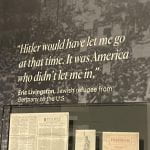
We departed from class at 2:15 and started preparing for the interview. We entered the zoom at 2:30, due to a technical glitch, we actually joined at 2:38. “Can you explain to us why you decided to join the ADL and why you’ve stayed there?” Shaffer asked after Dante officially dismissed our tardiness. Scott said that while he focused primarily on civil rights problems throughout law school, which helped organizations like the ADL, he yearned for a more practical experience. He tried to reunite and reconstruct the Jewish community before he joined the ADL because the iron curtain was coming down. He assisted Holocaust survivors during this time. Additionally, it gave me a fresh perspective on the Cold War. Nevertheless, he assists all minorities, not only Jews. He also gave us more information about how his children are coping with and learning about issues he has never had to, such antisemitism, which illustrates how quickly and widely it spread. Social media is primarily to blame for the rapid surge of antisemitism. We can see that there were just 12 instances of antisemitism in NJ in 2017, as opposed to 179 cases in 2020. Additionally, New York has the most antisemitic incidents. Nevertheless, there has been an increase in hate crimes against minorities across the US, and there are a few causes for this. One is that social media helps bring hateful people together and turn people against each other.
In the past, if you wanted your message to be heard by everyone, you had to go to a radio station or a newspaper publisher and ask them to input your message. However, doing so would result in negative publicity, so this rarely happened. Nowadays, you can easily go to a media app and post pretty much anything you want. Another reason is that due to polarization, the opposing side is unable to hear what we have to say. Additionally, it provides people with a justification for hiding their side’s ideas in order to promote their ideology. Last but not least, it demonstrates how those on the right can only control those on the right, and vice versa for those on the left.
The spread of illiteracy across the US is extremely evident. It most frequently manifests in seven pervasive myths about Jews. Which are: Jews hold sway over the world. They have a financial connection. They only have loyalty for Israel. They are different from non-Jews and offer Jewish people benefits. Christ was murdered, according to Jewish tradition, but the pope has refuted this idea, saying it is untrue. that there was no Holocaust! The last is anti-Israel sentiment.
Personally, I was startled to learn just how awful things truly are for minorities in the US and how they are most likely going to get a lot worse very rapidly. Sadly, this also clearly demonstrates the fundamental flaws in both democracy and freedom. The fact that New York has the highest number of anti-Semitic occurrences surprised me the most because I had always considered it to be one of the safest locations for Jews. However, I can now see that their high population made them a more attractive target.
Read more
















